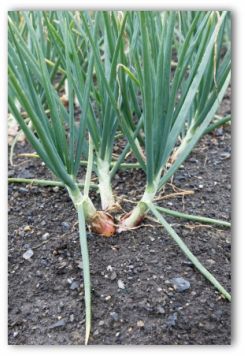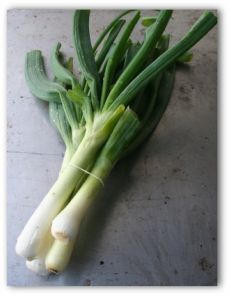Growing Shallots
in Your Backyard

Easy tips for growing shallots in your backyard vegetable garden.
Learn how to plant, grow, and care for shallot plants when home vegetable gardening.
Try planting shallots in your vegetable garden this year!
Design Your Own Vegetable Garden Layout Using our Free "Vegetable Garden Planner" Software!
Shallots are easily grown in a traditional backyard garden, or raised bed vegetable garden.
Shallots add a mild delicious flavor to many dishes, and can be a refreshing substitute in recipes calling for onions and garlic.
Shallots can be grown from seed, or "sets" which are small bulbs which can be planted directly in the ground.
- When planning your vegetable garden, be sure to include a row of shallots in your garden design.
- Shallots are easy to grow and can be recommended for even beginners at gardening.
Download Free Garden Planning Worksheets, Garden Diary, Zone Chart, Or Planting Guide
-
Shallots are alliums, included in the lily family with onions, chives, leeks, and garlic.
- Growing shallots can be a part of every successful home garden plot.
- Shallots are different from onions in their coppery skin and tapered shape.
- The flavor is mild and sweet compared to their onion and garlic cousins.
- Returning Crusaders in the 12th century brought shallots home to Europe as valued treasure from ancient Palestine.

Gardening has come a long way, and to achieve real success, planters learn from experience digging in the dirt.
All About Growing Shallots
- Crops are harvested on demand fresh from the ground.
- Pesticides are known and if used, should carefully applied.
- Shallots can be picked at the peak of ripeness.
- Varieties from strong to mild tasting flavor can be grown.
- Hard to find bulbs can be shared among gardeners.
- When planting shallots, space 6 to 8 inches apart in a well-prepared bed.
Planting Shallots
Shallots grown from sets rarely produces big bulbs in hot weather regions.
Northern varieties need long days of late spring and summer to swell to mature size.
If you live in a warm climate, growing a Northern variety makes great scallions for delicious salads and dips.
Most growing shallots are pest free, but can be damaged by onion maggots or thrips. The insects have growth stages from larva to adult, resembling flies. It feeds on onions left in the ground or discarded in piles.
Thrips are small black or yellow insects. It rasps leaves and flowers to suck out the juices. Plant portions affected will curl and brown. The tiny invaders may often be overlooked until major damage has occurred.
How to Grow Shallots that Stay Healthy
- Plant in sunny locations.
- Make certain soil drains well.
- Remove old plant debris.
- Till soil before planting.
- Use mulch to reduce weeds.
Certain shallot varieties have a sweet onion flavor with a slight taste of garlic, a close relative.
Although it can be eaten fresh, garlic is usually used in cooking.
Divide a bulb into individual cloves and push into loose fertile soil.
Space about six inches apart.

To produce well-defined cloves of shallot, feed plants often.
Harvest in spring when the leaves start to yellow and collapse.
Save extra shallot bulbs to replant in the cool fall season.
Considering the price of onions at the grocery store added up over a season compared to the cost of seeds, growing shallots are a valuable savings in any gardener’s neck of the woods.
Growing shallots is an easy addition to any vegetable garden.
Planting shallots is a great idea if you like the flavor of onions or garlic, but want a milder version in your recipe.
Vegetable gardening with shallots is a good way to save money, and enjoy eating the fruits of your labor at the same time.
Many Rewards of Vegetable Gardening
One of the many rewards of growing your own produce is the sense of pride and accomplishment in a job well done!
It's also good to know that you can depend on yourself for providing much of your basic food supply by growing vegetables such as tomatoes, lettuce, radish, carrots, green beans, peppers, onions, garlic, shallots, zucchini, squash, potatoes, eggplant and others in your home garden.
Backyard or container vegetable gardening is projected to grow by seven million Americans households in 2010 over previous years.
The main reason for this increase in gardening is that growing a garden is a tasty way to save money on food budgets and serve nutritious meals!
Feeding your family wholesome vegetables and stocking the freezer and pantry are just a few of the dollar saving reasons for planting seasonal gardens.
Many gardeners also enjoy growing plants as an edible hobby! The health benefits include getting plenty of daily exercise, sunshine, stress relief, and fresh air.
Fresh garden produce is a noticeable flavor improvement over vegetables purchased at the grocery store or supermarket.
Your fresh garden vegetables also make a great and welcome gift to your friends and neighbors.
Growing Shallots to Vegetable Gardening

